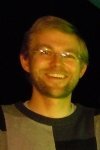Prof. Dr. Markus RASCHKE
Prof. Markus RASCHKE
Image: PrivateMarkus Raschke, professor at the University of Colorado, is Visiting Professor in May and June 2012 at the Abbe School of Photonics. During his stay he will give a series of lectures on nonlinear and ultrafast nano-optics.
Markus Raschke is a professor at the Department of Physics, Department of Chemistry, and JILA at the University of Colorado at Boulder. The research in his group is on the development of new nano-scale nonlinear and ultrafast spectroscopy techniques to control the light-matter interaction on the nanoscale and image domain order correlated matter. He received his PhD in 2000 from the Max-Planck Institute of Quantum Optics and the Technical University in Munich, Germany. Following research appointments at the University of California at Berkeley, and the Max-Born-Institute in Berlin, he became faculty member at the University of Washington, before moving with his group to Boulder in 2010.
www.nano-optics.colorado.eduExternal link
Lecture 1: Ultrafast Nano-Optics with Optical Antennas
Time: May 11, 2012, 15:00
Place: Lecture hall 1, Max-Wien-Platz 1, 07743 Jena
Combining plasmonic and optical antenna concepts with ultrafast and shaped laser pulses allows for the precise control of an optical excitation on femtosecond time and nanometer length scales. I will present several new concepts extending tip-enhanced spectroscopy into the nonlinear and ultrafast regime for nano-scale imaging and spectroscopy of surface molecules and nano-solids. Examples include adiabatic nano-focusing on a tip for nano-spectroscopy, spatio-temporal superfocusing and optical control at the 10 nm-10 fs level, and ultrafast free-induction decay near-field nano-IR spectroscopy of organic nano-structures. I will conclude with an outlook for future directions including the possibility for extreme nonlinear optics, strong light matter interaction, and radiative decay engineering.
Lecture 2: Ultrafast and Nonlinear Plasmon Dynamics (part 1)
Time: May 14, 2012, 15:00
Place: Fraunhofer IOF Jena, Carl-Zeiss lecture hall, Albert-Einstein-Str. 7, 07743 Jena
The interaction of light with metals can give rise to surface plasmon excitation in metals. The combination of structural parameter (extrinsic resonances) and optical dielectric properties of the metal (intrinsic resonances) determine the resulting macroscopic optical response. We will discuss both the resulting linear and nonlinear optical characteristics of surface plasmons. In particular the nonlinear properties are characterized by distinct selection rules. We will study how the investigations of surface plasmons in nano-structures can serve as a laboratory for understanding the elementary processes underlying the elementary excitation and relaxation processes in the metal. This insight will help understand the range and limitations of the use of surface plasmons to control optical fields in space and time. We will look into different ultrafast spectroscopy techniques to address the few femtosecond dynamics of surface plasmons.
Ultrafast and nonlinear plasmon dynamics (part 1)
Lecture 3: Ultrafast and Nonlinear Plasmon Dynamics (part 2)
Time: May 21, 2012, 15:00
Place: Fraunhofer IOF Jena, Carl-Zeiss lecture hall, Albert-Einstein-Str. 7, 07743 Jena
The interaction of light with metals can give rise to surface plasmon excitation in metals. The combination of structural parameter (extrinsic resonances) and optical dielectric properties of the metal (intrinsic resonances) determine the resulting macroscopic optical response. We will discuss both the resulting linear and nonlinear optical characteristics of surface plasmons. In particular the nonlinear properties are characterized by distinct selection rules. We will study how the investigations of surface plasmons in nano-structures can serve as a laboratory for understanding the elementary processes underlying the elementary excitation and relaxation processes in the metal. This insight will help understand the range and limitations of the use of surface plasmons to control optical fields in space and time. We will look into different ultrafast spectroscopy techniques to address the few femtosecond dynamics of surface plasmons.
Ultrafast and nonlinear plasmon dynamics (part 2)
Courses implemented in the lecture 'Introduction to Nanooptics'
for details click hereExternal link
